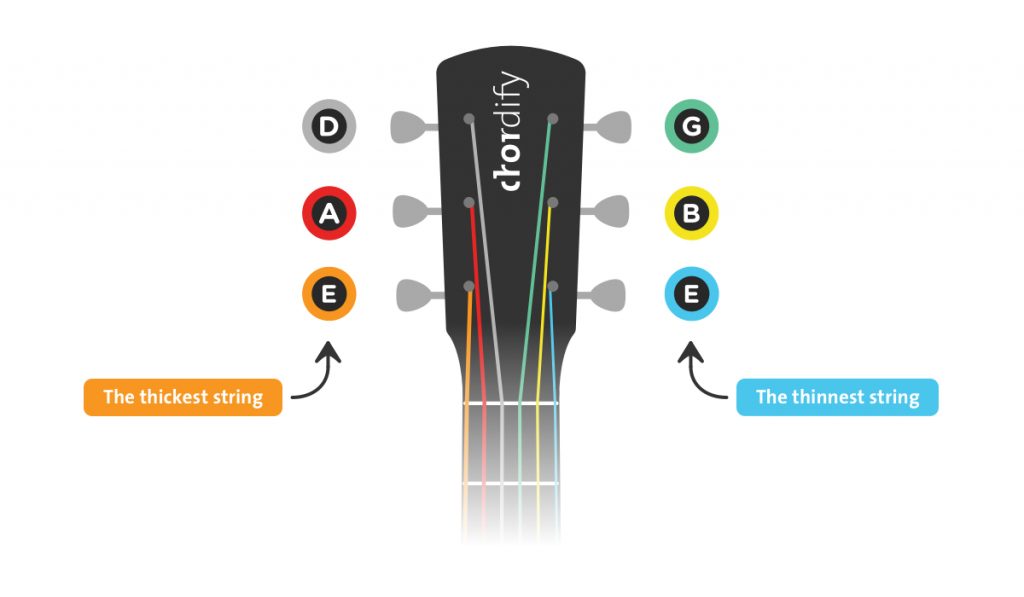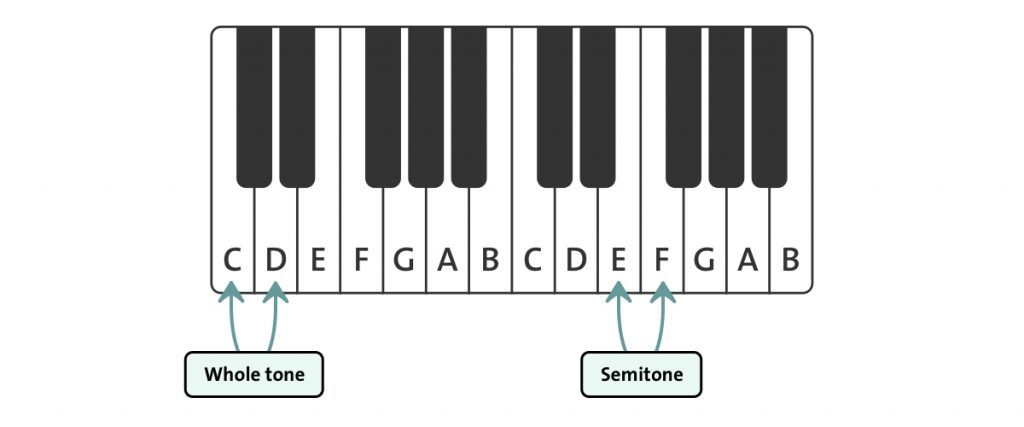Ever wondered how to make sense of the fretboard? In this article we will unlock all the secrets that it holds. From how to play scales and use simple fret positions, to easy ways to find chords. Consider this article as a map for your guitar fretboard. Ready? And off we go…
In this blogpost about the guitar fretboard you will find
- Main takeaway
- Tune your guitar
- Notes on the fretboard
- Intervals
- Whole tone – skipping one fret
- Semitone – transition to an adjacent fret up or down
- Enharmonic equivalent
- What is a sharp (#) and what is a flat (b)?
- Intervals on the fretboard: octaves, fourths, fifths
- Scales on the guitar fretboard
- The C major scale
- How to play the C major scale on the guitar fretboard
- One principle to play major scales – example with D major
- Final thoughts
When we play the guitar we move up and down the fretboard. Doing this is an adventure into the world of notes and their location. By the way, when going on a trip, it would be nice to take a map. So this article is your navigator which will help you explore new chord shapes, intervals, and scales on different frets.
Main takeaway
This is what you can expect from this blog post. First, we’ll explain the notes on the fretboard. Then, we’ll show you how to find important and very basic intervals like the octave, the fourth and the fifth.
Last but not least, we have a little treat for the hands-on, ready-for-action nerds where we explain how we can use this map to find a C major scale. All this basic knowledge will help you to understand the fretboard better and better. Therefore, you can master your guitar. Sounds good, right?
Tune your guitar
Every fret on your guitar stands for one certain note, and sometimes it can even combine two notes. Let’s start with naming the open strings. An open string refers to playing a string without pressing it on the fretboard. In the figure below, you can see which note stands for which open string. The letters are the same as the ones you see on your tuner, when you’re tuning your guitar in standard tuning.

Notes on the fretboard
Here is the guitar fretboard with the main notes pointed out. “Aren’t there more notes?” Yeah, good question, and we’ll get to that in a bit. First, check out the figure below.

As you can see, some notes are neighbors; they are located on adjacent frets. While other notes are just one fret up or a fret down from each other. This is a very important observation because in music theory we have different distances between notes. These distances are called intervals and the smallest intervals that can be counted are whole tones and semitones.
Intervals
Let’s look at the intervals between the following seven notes: C, D, E, F, G, A, B. The image below shows that some distances are marked as whole tones, while some are semitones. This given of music theory becomes even more apparent when we look at a piano keyboard. All the notes below are white keys, mixed with black keys.

When we move from C to D, we’re crossing a black key. That means we have a whole tone distance. However, between E and F we don’t have a black key. That means here we have a semitone distance. But how does this work on a fretboard? Again, good question. Let us explain how you can find these two distances on the guitar neck.

Whole tone – skipping one fret
Let’s stick with the example of C and D. The C is located on the fifth fret of the G string. Notice that on the guitar fretboard we can find the same note on a few different strings located on different frets! Remember that going from C to D on the piano keyboard we crossed a black key? We do the same on the guitar fretboard, crossing the sixth fret. Therefore, the D note is located on the seventh fret, as you can see in the picture below.
Semitone – transition to an adjacent fret up or down
Let’s stick with the example of E and F. The E is located on the ninth fret of the G string. Remember that, when going from E to F on the piano keyboard, we didn’t encounter a black key. Therefore, moving to the adjacent fret (10th fret) we get the F note (see the picture below).

Enharmonic equivalent
“What about those black keys we’re skipping?” Good question. Have you ever seen this symbol # behind the name of a note like C#? And how about this one: b? This is what we call accidentals. “What?!” Yeah those are the symbols behind the names of the notes we call sharp (#), flat (b) and natural (natural is just the name of the note without any sharps or flats).
Here we just summarize that a sharp increases a specific note one fret up (one semitone up), a flat drops a certain note one fret down (one semitone down), a natural returns the original pitch of the note. A note’s name stays the same except for the addition of sharp, flat or natural symbols.
Now it’s time to talk about enharmonic equivalents. Yeah, that’s a mouth full, we know. The real question is of course: What does it mean? Let’s go back to the example of the C and the D notes on the G string of the guitar. So, the C is on the fifth fret and the D is on the seventh fret. What lies between them on the sixth fret?
On this fret we have two notes: C# (pronounced C sharp) and Db (pronounced D flat) — remember the accidentals. Actually, on guitar the C# and Db have the same pitch or sound if you will, but they are named differently.

What is a sharp (#) and what is a flat (b)?
Remember that a sharp (#) pitches a note half a step up, and a flat (b) pitches a note down half a step. The name depends on the way you move: up or down the fretboard. Down is a flat (b) and up is a sharp (#).
This is, however, oversimplified. The real music theory is a bit more complicated because the then name actually depends on the current key. Some sharp keys have a G#; some flat keys have an Ab. So, you can name a note depending on the current key. In the picture below, you can see all enharmonic possibilities in light green up and until the 12th fret.

Since you understand this principle now, you can apply it to the fretboard after the 12th fret. It depends on how far your fingers usually go.
Intervals on the fretboard: octaves, fourths, fifths
Knowing how to find octaves, fourths and fifths is very important. For instance, these intervals form the basis of the blues and rock ’n’ roll genres. Furthermore, fifths and octaves are part of the famous power chords on guitar. So, we hope you’re convinced that it’s worth spending some time learning these intervals on your guitar. Let’s go!
How to find octaves on the fretboard
When we’re playing octaves, we use a pair of strings. These are not adjacent strings. In this part, we’ll show you two ways to play octaves on guitar. The first way is a pair of strings that are separated by one string. In this case, there are four combinations.

The second way of finding octaves is a pair of strings separated by two strings. For instance, in the open C chord the fifth and second string make an octave. In the figure below, you’ll see that we have three combinations for guitar. We’ve highlighted the way you can find the octave for the E, G, and D, but this principle goes for any note.

Practice the octaves for a while. And when you’re done, we’ll proceed with the intervals for the fourths and fifths.
How to find fourths on the fretboard
We have a way to find fourths from each string up to the next. In other words, we find these intervals on adjacent strings. Here is how you find fourths on your guitar.

How to find fifths on the fretboard
Here is the way to find fifths from each string up to the next adjacent string on the guitar fretboard. Remember that a root note and a fifth form a harmonic that you also know as a power chord. Power chords asre great if you love your rock, hardrock, and metal jams.

At this point you are probably overwhelmed with all these lines and dots. Don’t worry, take your time! Here is a good exercise to practice what you’ve learned: Pick any note on the fretboard and try to find all three intervals for that note: octave (in two different ways if possible), fourth, and fifth.
Scales on the guitar fretboard
We’ve been talking about 4th, 5th, and 3d notes, but what do these numbers stand for? It’s pretty easy actually; a scale is a collection of notes, determined by the key of a piece of music. A scale consists of seven notes, and depending on the key each number refers to the note that represents that position in the specific scale. Yeah it does sound a bit vague doesn’t it? Read on, and we’ll explain everything.
Why is it so important to be able to find and play certain scales on your guitar? Well, knowing scales will definitely help you to understand how a song was created. Therefore, you can jam over songs or just add some notes from the scale to your chords.
The C major scale
There are many different types of scales. In this article we’ll show you how to find the C major scale and by doing so we’re actually handing you the key to unlock the door to a lot of other major scales. Just read on and you’ll see what we’re talking about.
The C major scale is a very basic scale. It doesn’t have any accidentals (sharps or flats). Therefore, it can easily be played on piano by using only white keys. And we have some very good news for the guitarists: When you know how to play the C major scale in a certain position, you can use the same fingering on different frets to get other major scales. Sounds good, right? That’s what we thought. So, let’s get started!
The C major scale contains the following notes: C, D, E, F, G, A, B and C again. Remember that we talked about distances between notes in the beginning of this article? The example that we used earlier was actually the C major scale. It looks like this.

How to play the C major scale on the guitar fretboard
Let’s take a closer look at this scale on the guitar fretboard. First of all, on guitar the scale will contain three C notes: A string third fret, G string fifth fret, E string eighth fret. It means that we have two octaves here: from the C note on the A string to the C on the G string; and from the C note on the G string to the C note on the E string. See the picture below.

In the next picture we’ve highlighted the notes from the C major scale. To make it even easier, we’ve added some arrows to show the direction from one note to another.

One principle to play major scales – example with D major
Now let’s try to transpose this scale. How about we try to play the D major scale. Which frets will be involved? In the case of the guitar we have a D note on the fifth fret of the A string. Take this D as your starting position and play the same pattern as the one you just did for the C major.

As you can see in the picture above, for the D major scale the pattern remains the same, but the whole position moved two frets up.
Final thoughts
Is your head almost bursting with all this new information? And are your fingers burning from practicing? It’s okay, don’t worry too much about it. This kind of stuff isn’t very easy when you’re learning it, it becomes very easy once you understand it.
Yeah, that’s the way the cookie crumbles with most skills, isn’t it? Just keep practicing and don’t look at the details too much for now. Try to get the bigger picture, so your understanding of the fretboard expands. Happy jamming!


